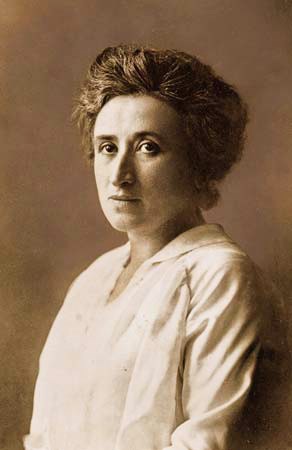Almost nine years ago the Sechelt Public Library received a phone call from Berlin. A retired museum curator was interested in helping his friend solve the mystery of a preserved headless corpse which had been lying in the mortuary of the Berlin Charity Hospital for over 80 years. His friend, the forensic pathologist at the hospital, had questions regarding the original autopsy, which had been performed in 1919. He found the body showed signs of having been in water for some time, it was of a 40 to 50 year old woman who had suffered from osteoarthritis and had legs of different lengths. Carbon dating confirmed it dated from the same time as Rosa Luxemburg’s death.
Rosa Luxemburg, born in Poland in 1871, was a revolutionary socialist and agitator who played a key role in the founding of the Spartacus League, which grew into the Communist Party of Germany. During the First World War, Luxemburg was imprisoned in Germany for her anti-war activities. After her release in November 1918 following the abdication of the Kaiser, Luxemburg and fellow revolutionary Karl Liebknecht “immediately began agitation to force the new order to the left,” says Encyclopaedia Britannica.
“They exercised considerable influence on the public and were a contributing factor in a number of armed clashes in Berlin. As a result, Luxemburg was vilified as ‘Bloody Rosa’ in the bourgeois press.”
In January 1919, the army was called in to subdue the uprising and Luxemburg and Liebknecht were arrested. While being transported to prison they were killed by members of the Freikorps militia. Luxemburg’s headless body was flung in Berlin’s Landwehr Canal where it lay for four months until found and identified and supposedly buried in a Berlin cemetery. However when opened many years later, the grave was found to be empty.
Luxemburg’s friend and mentor, German-born Clara Zetkin, held similar views, for which she was exiled to Zurich and Paris prior to the First World War. After Hitler came to power and banned the Communist Party from the Reichstag following the fire there in 1933, Zetkin went into exile for the last time to the Soviet Union. There she died in 1936 and was buried by the Kremlin Wall.
One of Zetkin’s sons, Konstantin (Kostja), had been Rosa Luxemburg’s lover and it is he who connects Luxemburg to the Sunshine Coast. He and his wife Gertrude were doctors in Berlin until after the Second World War when they came to the United States where Gertrude had relatives. There they were viewed with suspicion because of Kostja’s mother’s and his connections to democratic socialism and to the Communist Party. Finally they retired to lead a quiet life at the cottage of Gertrude’s sister, Thea Leuchte, at Middle Point.
The phone call to the Sechelt Public Library led to numerous emails and phone calls to and from various relatives and friends of the Zetkins, but the Sunshine Coast sleuths’ efforts were in vain; no one had any mementos of Rosa Luxemburg that may have had DNA traces of her. The Berlin forensic pathologist was able to trace a great-niece of Luxemburg’s in Poland who donated hair samples for DNA testing. These proved almost conclusively that the corpse was Rosa Luxemburg. The headless corpse now occupies Rosa Luxemburg’s previously empty grave.
– Ann Watson, Sechelt Community Archives



